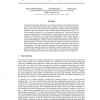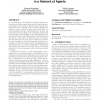248 search results - page 26 / 50 » Learning the Structure of Dynamic Probabilistic Networks |
NIPS
2007
13 years 9 months ago
2007
Unsupervised learning algorithms aim to discover the structure hidden in the data, and to learn representations that are more suitable as input to a supervised machine than the ra...
ATAL
2005
Springer
14 years 1 months ago
2005
Springer
Many multi-agent systems consist of a complex network of autonomous yet interdependent agents. Examples of such networked multi-agent systems include supply chains and sensor netw...
ICML
2006
IEEE
14 years 8 months ago
2006
IEEE
We introduce Hidden Process Models (HPMs), a class of probabilistic models for multivariate time series data. The design of HPMs has been motivated by the challenges of modeling h...
ATAL
2007
Springer
14 years 1 months ago
2007
Springer
To cope with large scale, agents are usually organized in a network such that an agent interacts only with its immediate neighbors in the network. Reinforcement learning technique...
CMOT
2004
13 years 7 months ago
2004
Social action is situated in fields that are simultaneously composed of interpersonal ties and relations among organizations, which are both usefully characterized as social netwo...


